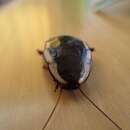en
names in breadcrumbs


Drymaplaneta semivitta is a species of cockroach native to Australia and introduced to New Zealand. In New Zealand, it is known as the Gisborne cockroach, after the city of Gisborne where it was first discovered in the country.[2]It has also been claimed to have first appeared in Tauranga in 1954, probably arriving on a log shipment.[3]
One of the larger cockroaches, Drymaplaneta semivitta is about 20–45mm long[2][4] and 12–15mm wide.[5] It is a glossy dark brown, with distinctive tan or white coloured translucent stripes along each side of its head.[4][5][6] Unlike many cockroaches, it has no vestigial wings.[2][5][6]
In males, the third and fourth maxillary palps are enlarged, and the hind tibiae are flattened and expanded.[7][1]
D. semivitta is often found in wood material, such as timber or bark chips.[2][4][8] It feeds off organic material but does not normally infest food.[2] In cold weather, it can be found in roof cavities and the empty spaces between walls.[5] D. semivitta is generally regarded as harmless.[8]
Hex-2-enal is present in the defensive secretions of D. semivitta. This chemical also occurs in some other species of Drymaplaneta.[9]
D. semivitta is most often found in Melbourne, Sydney,[6] and throughout the North Island of New Zealand, and also in Nelson and Blenheim,[2] although it has been found as far south as Timaru.[8]
 A Gisborne cockroach in Auckland
A Gisborne cockroach in Auckland  The same individual as above
The same individual as above Drymaplaneta semivitta is a species of cockroach native to Australia and introduced to New Zealand. In New Zealand, it is known as the Gisborne cockroach, after the city of Gisborne where it was first discovered in the country.It has also been claimed to have first appeared in Tauranga in 1954, probably arriving on a log shipment.
Drymaplaneta semivitta est une espèce de blattes originaire d'Australie et introduite en Nouvelle-Zélande. En Nouvelle-Zélande, elle est connue sous le nom de « Gisborne cockroach » (cafard de Gisborne), du nom de la ville de Gisborne où elle a été découverte pour la première fois dans ce pays[2].
Drymaplaneta semivitta est une des plus grandes blattes, avec environ 20 à 45 mm de long[2],[3] et 12 à 15 mm de large[4]. Elle est d'un brun foncé brillant, avec des rayures translucides beiges ou blanches caractéristiques de chaque côté de la tête[3],[4],[5]. Contrairement à beaucoup d'autres blattes, elle n'a pas d'ailes résiduelles[2],[4],[5].
Chez les mâles, les troisième et quatrième palpes maxillaires sont élargis et les tibias postérieurs sont aplatis et élargis[6],[1].
Un spécimen à Auckland.
D. semivitta se trouve souvent dans des matériaux en bois comme des troncs ou des copeaux d'écorce[2],[3],[7]. Elle se nourrit de matières organiques mais n'infeste normalement pas les aliments[2]. Par temps froid, on peut la trouver dans les cavités des toits et les espaces vides entre les murs[4]. Elle est généralement considérée comme inoffensive[7].
L'aldéhyde 2-Hexenal (de) est présent dans les sécrétions défensives de D. semivitta, comme chez d'autres espèces du genre DrymaplanetaDrymaplaneta[8].
En Australie, D. semivitta se trouve le plus souvent à Melbourne et à Sydney[5], et en Nouvelle-Zélande dans toute l'île du Nord, ainsi qu'à Nelson et Blenheim[2], bien qu'elle ait été trouvée aussi loin au sud que Timaru[7].
Drymaplaneta semivitta est une espèce de blattes originaire d'Australie et introduite en Nouvelle-Zélande. En Nouvelle-Zélande, elle est connue sous le nom de « Gisborne cockroach » (cafard de Gisborne), du nom de la ville de Gisborne où elle a été découverte pour la première fois dans ce pays.
Drymaplaneta semivitta is een insect uit de orde kakkerlakken (Blattodea) en de familie Blattidae. De soort werd voor het eerst wetenschappelijk gepubliceerd door Walker in 1868.
De kakkerlak heeft een zeer plat lichaam en een donkere kleur.
Drymaplaneta semivitta is een insect uit de orde kakkerlakken (Blattodea) en de familie Blattidae. De soort werd voor het eerst wetenschappelijk gepubliceerd door Walker in 1868.
De kakkerlak heeft een zeer plat lichaam en een donkere kleur.